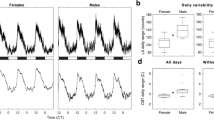Abstract
The objective of this work was to identify strain-specific characteristics from real-time measurements of circadian rhythms of two inbred mouse strains. In particular, heart rate, temperature, and activity data collected from A/J and C57BL/6J (B6) mice using telemetry are analyzed. The influence of activity on heart rate and temperature is minimized by correlation analysis followed by regression analysis. The correlation analysis is used to determine the length of the activity data filter that results in the best correlation between activity data and heart rate or temperature. After the activity data are filtered, they are used in regression analysis. The temperature and heart rate rhythms obtained as the intercepts of the regression analysis are interpreted as the zero-activity rhythms and consequently are good estimates of the circadian rhythms. The circadian temperature rhythms for the B6 mice follow a smoother cosine-like time waveform, whereas those for the A/J mice follow a more square-wave-like waveform. To quantify the difference between these two temperature rhythms, a feature based on Fourier analysis of the time-series data is used. Detrended fluctuation analysis is used to identify features in the heart rate rhythms. The results of this work show that the features for the circadian temperature and heart rate rhythms can be used as distinguishing characteristics of the A/J and B6 strains. This work provides the foundation for future studies directed at investigating the influence of chromosomal substitutions on the regulation of circadian rhythms in these two strains.




Similar content being viewed by others
References
Devore JL (1991) Probability and statistics for engineering and the sciences, 3rd edn. Brooks/Cole Publishing Co, Pacific Grove, CA
Green C, Takahashi J (2006) Xenobiotic metabolism in the fourth dimension: partners in time. Cell Metab 4(1):3–4
Hoit B, Kiatchoosakun S, Restivo J, Kirkpatrick D, Olszens K et al (2002) Naturally occurring variation in cardiovascular traits among inbred mouse strains. Genomics 79(5):679–685
King DP, Zhao Y, Sangoram AM, Wilsbacher LD, Tanaka M et al (1997) Positional cloning of the mouse circadian clock gene. Cell 89(4):641–653
Laposky AD, Shelton J, Bass J, Dugovic C, Perrino N et al (2006) Altered sleep regulation in leptin-deficient mice. Am J Physiol Regul Integr Comp Physiol 290(4):894–903
Li P, Sur S, Mistlberger R, Morris M (1999) Circadian blood pressure and heart rate rhythms in mice. J Physiol 276(2 Pt 2):R500–R504
Nadeau J, Singer J, Matin A, Lander E (2000) Analyzing complex traits with chromosome substitution strains. Nat Genet 24:221–225
Oppenheim A, Willsky A, Nawab S (1996) Signals and systems, 2nd edn. Prentice-Hall, Upper Saddle River, NJ
Peng C, Havlin S, Stanley H, Goldberger A (1995) Quantification of scaling exponents and crossover phenomena in nonstationary heartbeat time series. Chaos 5:82–87
Tankersley C, Irizarry R, Flanders S, Rabold R (2002) Circadian rhythm variation in activity, body temperature, and heart rate between c3h/hej and c57bl/6j inbred strains. J Appl Physiol 92(2):870–877
Turek FW, Joshu C, Kohsaka A, Lin E, Ivanova G et al (2005) Obesity and metabolic syndrome in circadian clock mutant mice. Science 308(5724):1043–1045
Vitaterna MH, King DP, Chang AM, Kornhauser JM, Lowrey PL et al (1994) Mutagenesis and mapping of a mouse gene, clock, essential for circadian behavior. Science 264(5159):719–725
Weinert D, Nevill A, Weinandy R, Waterhouse J (2003) The development of new purification methods to assess the circadian rhythm of body temperature in Mongolian gerbils. Chronobiol Int 20(2):249–270
Weinert D, Waterhouse J (1998) Diurnally changing effects of locomotor activity on body temperature in laboratory mice. Physiol Behav 63(5):837–843
Zvonic S, Ptitsyn AA, Conrad SA, Scott LK, Floyd ZE et al (2006) Characterization of peripheral circadian clocks in adipose tissues. Diabetes 55(4):962–970
Acknowledgment
This work was supported by the National Science Foundation under Grant No. EIA-0329811.
Author information
Authors and Affiliations
Corresponding author
Rights and permissions
About this article
Cite this article
Gürkan, E., Olszens, K.R., Nadeau, J.H. et al. Feature identification in circadian rhythms of mice strains using in vivo information. Mamm Genome 19, 366–377 (2008). https://doi.org/10.1007/s00335-008-9118-9
Received:
Accepted:
Published:
Issue Date:
DOI: https://doi.org/10.1007/s00335-008-9118-9




